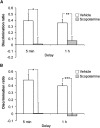Critical role of the cholinergic system for object-in-place associative recognition memory
- PMID: 19117911
- PMCID: PMC2632853
- DOI: 10.1101/lm.1121309
Critical role of the cholinergic system for object-in-place associative recognition memory
Abstract
Object-in-place memory, which relies on the formation of associations between an object and the place in which it was encountered, depends upon a neural circuit comprising the perirhinal (PRH) and medial prefrontal (mPFC) cortices. This study examined the contribution of muscarinic cholinergic neurotransmission within this circuit to such object-in-place associative memory. Intracerebral administration of scopolamine in the PRH or mPFC impaired memory acquisition, but not retrieval and importantly we showed that unilateral blockade of muscarinic receptors simultaneously in both regions in opposite hemispheres, significantly impaired performance. Thus, object-in-place associative memory depends upon cholinergic modulation of neurones within the PRH-PFC circuit.
Figures



Similar articles
-
Object-in-place associative recognition memory depends on glutamate receptor neurotransmission within two defined hippocampal-cortical circuits: a critical role for AMPA and NMDA receptors in the hippocampus, perirhinal, and prefrontal cortices.Cereb Cortex. 2015 Feb;25(2):472-81. doi: 10.1093/cercor/bht245. Epub 2013 Sep 12. Cereb Cortex. 2015. PMID: 24035904 Free PMC article.
-
NMDA receptor plasticity in the perirhinal and prefrontal cortices is crucial for the acquisition of long-term object-in-place associative memory.J Neurosci. 2008 Mar 12;28(11):2837-44. doi: 10.1523/JNEUROSCI.4447-07.2008. J Neurosci. 2008. PMID: 18337414 Free PMC article.
-
Evaluating the neural basis of temporal order memory for visual stimuli in the rat.Eur J Neurosci. 2011 Feb;33(4):705-16. doi: 10.1111/j.1460-9568.2010.07555.x. Epub 2011 Jan 13. Eur J Neurosci. 2011. PMID: 21226775
-
Behavioral pharmacology and biochemistry of central cholinergic neurotransmission.Adv Exp Med Biol. 1991;295:399-414. doi: 10.1007/978-1-4757-0145-6_23. Adv Exp Med Biol. 1991. PMID: 1663698 Review.
-
The role of medial prefrontal cortex in memory and decision making.Neuron. 2012 Dec 20;76(6):1057-70. doi: 10.1016/j.neuron.2012.12.002. Neuron. 2012. PMID: 23259943 Free PMC article. Review.
Cited by
-
Ngfr+ cholinergic projection from SI/nBM to mPFC selectively regulates temporal order recognition memory.Nat Commun. 2024 Aug 26;15(1):7342. doi: 10.1038/s41467-024-51707-w. Nat Commun. 2024. PMID: 39187496 Free PMC article.
-
Impaired object-location learning and recognition memory but enhanced sustained attention in M2 muscarinic receptor-deficient mice.Psychopharmacology (Berl). 2018 Dec;235(12):3495-3508. doi: 10.1007/s00213-018-5065-7. Epub 2018 Oct 16. Psychopharmacology (Berl). 2018. PMID: 30327842 Free PMC article.
-
Chronic nicotine improves cognitive and social impairment in mice overexpressing wild type α-synuclein.Neurobiol Dis. 2018 Sep;117:170-180. doi: 10.1016/j.nbd.2018.05.018. Epub 2018 Jun 1. Neurobiol Dis. 2018. PMID: 29859873 Free PMC article.
-
What pharmacological interventions indicate concerning the role of the perirhinal cortex in recognition memory.Neuropsychologia. 2012 Nov;50(13):3122-40. doi: 10.1016/j.neuropsychologia.2012.07.034. Epub 2012 Jul 27. Neuropsychologia. 2012. PMID: 22841990 Free PMC article. Review.
-
Altered object-in-place recognition memory, prepulse inhibition, and locomotor activity in the offspring of rats exposed to a viral mimetic during pregnancy.Neuroscience. 2012 Jan 10;201:184-98. doi: 10.1016/j.neuroscience.2011.11.011. Epub 2011 Nov 11. Neuroscience. 2012. PMID: 22119062 Free PMC article.
References
-
- Abe H., Ishida Y., Iwasaki T. Perirhinal N-methyl-D-aspartate and muscarinic systems participate in object recognition in rats. Neurosci. Lett. 2004;356:191–194. - PubMed
-
- Aigner T.G., Mishkin M. The effects of physostigmine and scopolamine on recognition memory in monkeys. Behav. Neural Biol. 1986;45:81–87. - PubMed
-
- Aigner T.G., Mitchell S.J., Aggleton J.P., DeLong M.R., Struble R.G., Price D.L., Wenk G.L., Pettigrew K.D., Mishkin M. Transient impairment of recognition memory following ibotenic-acid lesions of the basal forebrain in macaques. Exp. Brain Res. 1991;86:18–26. - PubMed
Publication types
MeSH terms
Substances
Grants and funding
LinkOut - more resources
Full Text Sources
Medical
Miscellaneous
